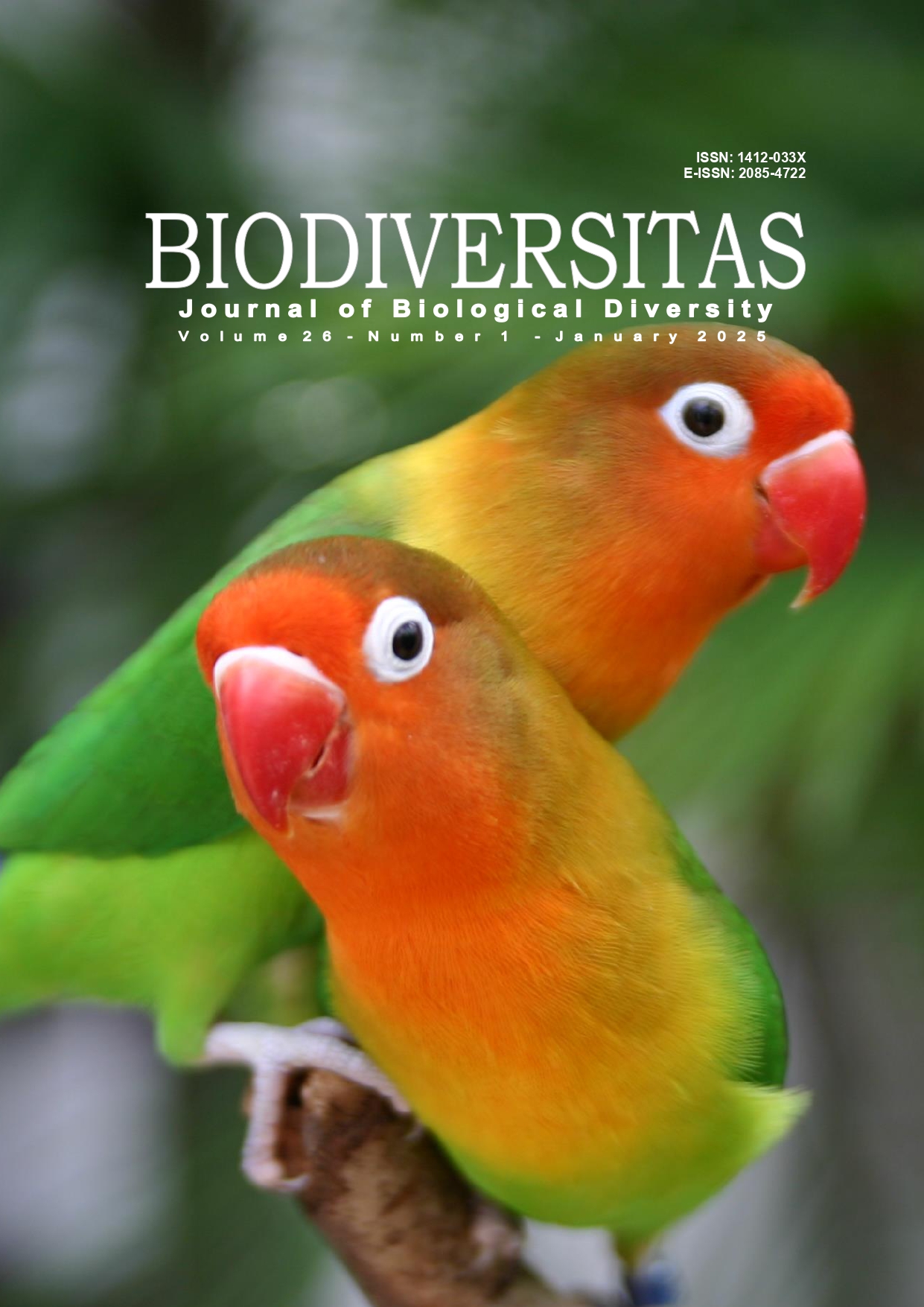Phytochemical screening and GC-MS analysis of local durian (Durio zibethinus) leaf extract from Criwik, Rembang, Central Java, Indonesia
##plugins.themes.bootstrap3.article.main##
Abstract
Abstract. Sawitri AD, Yuniastuti E, Purwanto E, Parjanto. 2025. Phytochemical screening and GC-MS analysis of local durian (Durio zibethinus) leaf extract from Criwik, Rembang, Central Java, Indonesia. Biodiversitas 26: 55-61. Durian (Durio zibethinus), an important tropical fruit in Indonesia, is widely known for its unique flavor and potential health benefits. Despite extensive research on the nutritional and pharmacological properties of its fruit, the bioactive potential of its other plant parts, particularly the leaves, remains limited. This study explored the phytochemical profile and bioactive compounds in the leaf extract of Criwik durian, a local variety from Rembang, Central Java, Indonesia. Phytochemical screening confirmed the presence of flavonoids, tannins, alkaloids, saponins, and phenolic compounds, all known for their diverse pharmacological activities, including antioxidant, anti-inflammatory, and antimicrobial properties. Importantly, this is the first study to report the presence of phytochemical in the durian leaf extract. Additionally, gas chromatography-mass spectrometry analysis was conducted to characterize the bioactive components, which identified 11 distinct compounds. These included squalene, ethyl iso allocholate, neophytadiene, and phytol, all associated with health remedies and pharmacological effects. These results provide a detailed chemical profile of Criwik durian leaves, highlighting their potential as a valuable resource for the development of natural health products and herbal remedies. These findings enhance our understanding of the bioactive potential of durian leaves and encourage further research into their medicinal applications. Thus, Criwik durian leaves could serve as a promising source for the future exploration of natural health product development and sustainable medicinal practices.
##plugins.themes.bootstrap3.article.details##
Most read articles by the same author(s)
- SLAMET SANTOSA, SUTARNO SUTARNO, EDI PURWANTO, SURANTO SURANTO, SAJIDAN SAJIDAN, Molecular characterization of Plant Growth Promoting Rhizobacteria using 16S rRNA sequences in the organic rice field of Sukorejo Village, Central Java, Indonesia , Biodiversitas Journal of Biological Diversity: Vol. 19 No. 6 (2018)
- IMANOVTA ICHTI SANTOSO PUTRI, ENDANG YUNIASTUTI, PARJANTO, The rambutan (Nephelium lappaceum L.) chromosomes , Biodiversitas Journal of Biological Diversity: Vol. 23 No. 4 (2022)
- INTAN WIDYA PANGESTIKA, ARI SUSILOWATI, EDI PURWANTO, Genetic diversity of Coffea canephora Pierre ex A. Froehner in Temanggung District, Indonesia based on molecular marker RAPD , Biodiversitas Journal of Biological Diversity: Vol. 22 No. 11 (2021)
- ZULFAHMI, PARJANTO, EDI PURWANTO, AHMAD YUNUS, Genetic diversity and population structure of Eurycoma apiculata in Eastern Sumatra, Indonesia , Biodiversitas Journal of Biological Diversity: Vol. 22 No. 10 (2021)
- ZULFAHMI, EDI PURWANTO, PARJANTO, AHMAD YUNUS, Phenotypic diversity and plasticity index of Eurycoma apiculata populations in Eastern Sumatra, Indonesia based on leaves morphology , Biodiversitas Journal of Biological Diversity: Vol. 21 No. 7 (2020)
- EDI PURWANTO, Study in the Responses of-Some Soybean (Glycine max L.) Cultivars Under Water Stress Condition , Biodiversitas Journal of Biological Diversity: Vol. 4 No. 1 (2003)
- WAFA’ NUR HANIFAH, PARJANTO, SRI HARTATI, AHMAD YUNUS, The performances of M4 generation of Mentik Susu rice mutants irradiated with gamma-ray , Biodiversitas Journal of Biological Diversity: Vol. 21 No. 9 (2020)
- MARINA RUZYATI, ATMITRI SISHARMINI, ANIVERSARI APRIANA, TRI JOKO SANTOSO, EDI PURWANTO, SAMANHUDI, AHMAD YUNUS, Construction of CRISPR/Cas9_gRNA-OsCKX2 module cassette and its introduction into rice cv. Mentik Wangi mediated by Agrobacterium tumefaciens , Biodiversitas Journal of Biological Diversity: Vol. 23 No. 5 (2022)
- NUR AZIZAH USWATUN HASANAH, EDI PURWANTO, PUJI HARSONO, SAMANHUDI, AMALIA TETRANI SAKYA, Morphological responses of six sorghum varieties on cadmium-contaminated soil , Biodiversitas Journal of Biological Diversity: Vol. 24 No. 7 (2023)
- ENDANG YUNIASTUTI, ANANDA PUTRI DEWANTARI MASAILLA, NANDARIYAH, NAILU RAHMAH, Karyotyping of green, yellow and red matoa (Pometia pinnata J.R.Forst. & G.Forst.) from Central Java, Indonesia , Biodiversitas Journal of Biological Diversity: Vol. 24 No. 1 (2023)

